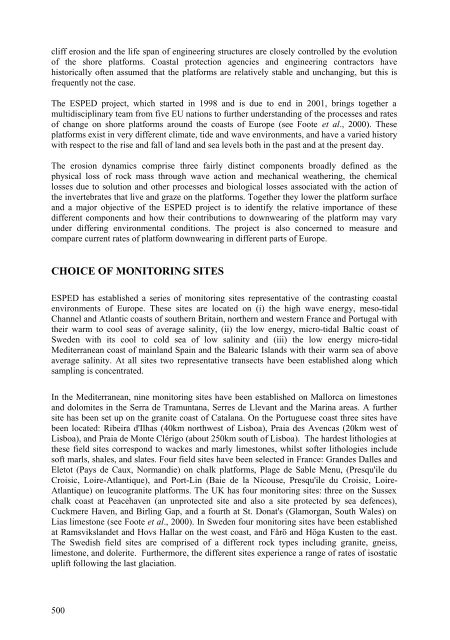EurOCEAN 2000 - Vlaams Instituut voor de Zee
EurOCEAN 2000 - Vlaams Instituut voor de Zee
EurOCEAN 2000 - Vlaams Instituut voor de Zee
Create successful ePaper yourself
Turn your PDF publications into a flip-book with our unique Google optimized e-Paper software.
cliff erosion and the life span of engineering structures are closely controlled by the evolution<br />
of the shore platforms. Coastal protection agencies and engineering contractors have<br />
historically often assumed that the platforms are relatively stable and unchanging, but this is<br />
frequently not the case.<br />
The ESPED project, which started in 1998 and is due to end in 2001, brings together a<br />
multidisciplinary team from five EU nations to further un<strong>de</strong>rstanding of the processes and rates<br />
of change on shore platforms around the coasts of Europe (see Foote et al., <strong>2000</strong>). These<br />
platforms exist in very different climate, ti<strong>de</strong> and wave environments, and have a varied history<br />
with respect to the rise and fall of land and sea levels both in the past and at the present day.<br />
The erosion dynamics comprise three fairly distinct components broadly <strong>de</strong>fined as the<br />
physical loss of rock mass through wave action and mechanical weathering, the chemical<br />
losses due to solution and other processes and biological losses associated with the action of<br />
the invertebrates that live and graze on the platforms. Together they lower the platform surface<br />
and a major objective of the ESPED project is to i<strong>de</strong>ntify the relative importance of these<br />
different components and how their contributions to downwearing of the platform may vary<br />
un<strong>de</strong>r differing environmental conditions. The project is also concerned to measure and<br />
compare current rates of platform downwearing in different parts of Europe.<br />
CHOICE OF MONITORING SITES<br />
ESPED has established a series of monitoring sites representative of the contrasting coastal<br />
environments of Europe. These sites are located on (i) the high wave energy, meso-tidal<br />
Channel and Atlantic coasts of southern Britain, northern and western France and Portugal with<br />
their warm to cool seas of average salinity, (ii) the low energy, micro-tidal Baltic coast of<br />
Swe<strong>de</strong>n with its cool to cold sea of low salinity and (iii) the low energy micro-tidal<br />
Mediterranean coast of mainland Spain and the Balearic Islands with their warm sea of above<br />
average salinity. At all sites two representative transects have been established along which<br />
sampling is concentrated.<br />
In the Mediterranean, nine monitoring sites have been established on Mallorca on limestones<br />
and dolomites in the Serra <strong>de</strong> Tramuntana, Serres <strong>de</strong> Llevant and the Marina areas. A further<br />
site has been set up on the granite coast of Catalana. On the Portuguese coast three sites have<br />
been located: Ribeira d'Ilhas (40km northwest of Lisboa), Praia <strong>de</strong>s Avencas (20km west of<br />
Lisboa), and Praia <strong>de</strong> Monte Clérigo (about 250km south of Lisboa). The har<strong>de</strong>st lithologies at<br />
these field sites correspond to wackes and marly limestones, whilst softer lithologies inclu<strong>de</strong><br />
soft marls, shales, and slates. Four field sites have been selected in France: Gran<strong>de</strong>s Dalles and<br />
Eletot (Pays <strong>de</strong> Caux, Normandie) on chalk platforms, Plage <strong>de</strong> Sable Menu, (Presqu'ile du<br />
Croisic, Loire-Atlantique), and Port-Lin (Baie <strong>de</strong> la Nicouse, Presqu'ile du Croisic, Loire-<br />
Atlantique) on leucogranite platforms. The UK has four monitoring sites: three on the Sussex<br />
chalk coast at Peacehaven (an unprotected site and also a site protected by sea <strong>de</strong>fences),<br />
Cuckmere Haven, and Birling Gap, and a fourth at St. Donat's (Glamorgan, South Wales) on<br />
Lias limestone (see Foote et al., <strong>2000</strong>). In Swe<strong>de</strong>n four monitoring sites have been established<br />
at Ramsvikslan<strong>de</strong>t and Hovs Hallar on the west coast, and Fårö and Höga Kusten to the east.<br />
The Swedish field sites are comprised of a different rock types including granite, gneiss,<br />
limestone, and dolerite. Furthermore, the different sites experience a range of rates of isostatic<br />
uplift following the last glaciation.<br />
500

















